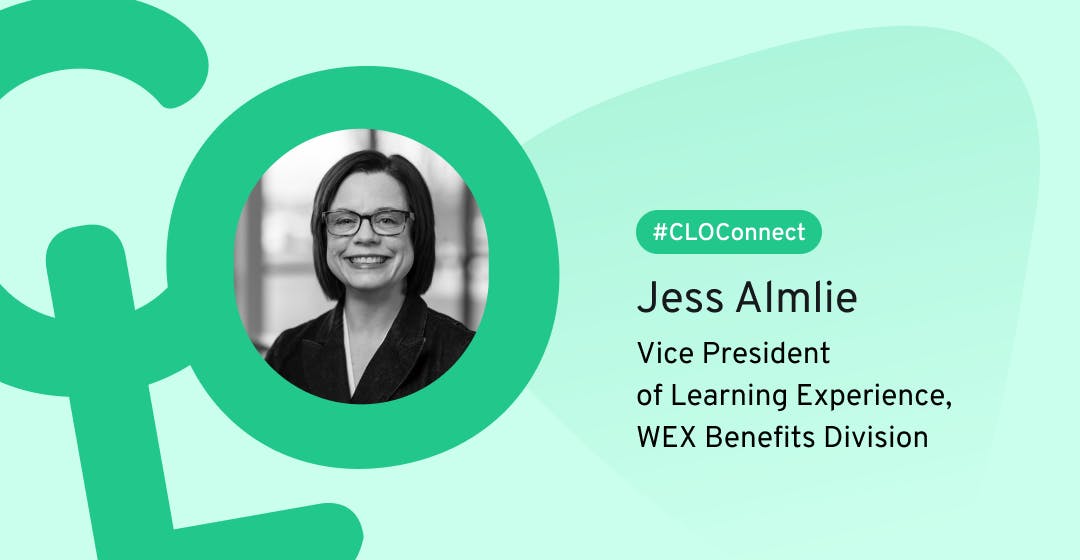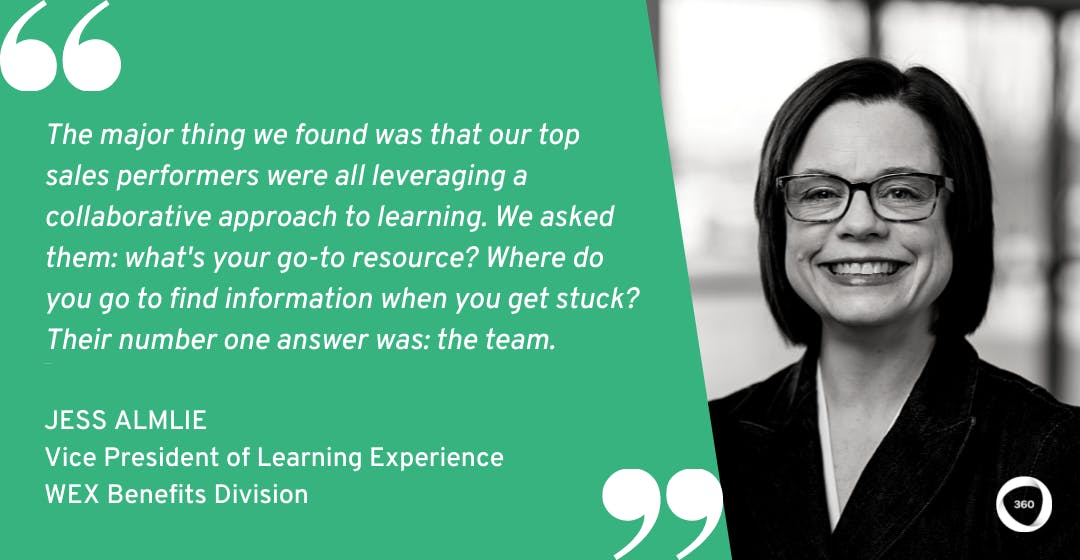
How WEX Uses Collaborative Learning to Capture and Replicate 3 Top Sales Behaviors
As any experienced L&D leader will tell you, there’s something uniquely challenging about boosting sales team performance. Sales enablement is the true engine room of every company, and yet, it’s often one of the trickiest parts of learning strategy.
One of the best ways to provide your sales reps with the support they need to grow? Capture the specific practices and behaviors shared by your top reps, and find a way to replicate them.
This is exactly how Jess Almlie, Vice President of Learning Experience at WEX, Benefits Division, supports her sales colleagues. Recently, Jess was kind enough to talk me through her performance consulting L&D approach, and the three behaviors WEX’s top reps all share.
We started our conversation with a little background on the WEX approach to L&D.
How WEX applies a performance consulting approach within L&D
As Jess explains, WEX is a big company with a big role to play for its clients and customers.
“WEX is primarily a payments and technology company,” she says. “We have three different divisions of payments: fleet payments, travel and corporate payments, and health. I oversee learning for the health division.”
“We have about 6,000 folks in total across our organization, including 2,000 in health. Our work in health is primarily related to benefits in the United States, offering flexible spending accounts, health savings accounts, and COBRA (Continuation of Health Coverage) insurance.”
“These are all services created by the government as ways for folks to help pay for their healthcare. They’re highly regulated, which means they come with some complexity, and it’s our business to simplify that. We have experts who know the ins and outs of those regulations, and all of the processes that go along with them.”
So, what do Jess and her team focus on in terms of L&D? “Internally, we oversee everyone who is onboarding and upskilling. Externally, we create education components responding to customer needs, which primarily take the form of webinars and videos.”
“Our internal strategy is blended, so we offer eLearning with interactive labs and structured shadowing. We have a team of 20 working within the L&D team. In addition to leading the team, I’m also creating and driving the strategy for learning in the health division.”
For Jess, a big part of this role involves maintaining close connections with people. “I build and maintain relationships with our unit leaders, so that we’re making sure we’re hitting the mark by helping them create the right business impact. I also do a lot of scope conversations and performance consulting conversations. In short, I just love my job.”
I build and maintain relationships with our unit leaders, so that we’re making sure we’re hitting the mark by helping them create the right business impact. I also do a lot of scope conversations and performance consulting conversations. In short, I just love my job.
You can never have enough expert insights! Check out our ebook to find out How L&D Can Help You Build a Strong Company Culture
The specific challenges of sales improvement at WEX
For Jess and her team, a big area of focus recently has been providing the tools and resources for WEX’s sales team to boost its performance.
“Every sales team has bigger and bigger numbers every single year,” says Jess. “That’s just how we help our companies to grow. This year, our sales team had a particularly large number that they wanted to hit. So, they came to us late last year and asked us to help with some training.”
Before she kicked off this project, Jess asked a key question. “Whenever somebody asks for training for an internal group that is already functioning well, I always ask: why? What’s the real issue here? It might be related to training, or it might not. I don’t want to provide training as a solution if that’s not going to help, because that’s a waste of company time and resources.”
“We dug deeper into the request and performed a gap analysis. We took their top performers and asked: what makes them better at sales? What have they figured out that the rest of the team hasn’t quite figured out yet? This way, we could raise the performance of the entire team.”
What did Jess and her team find out? “There wasn’t a gap in sales knowledge or principles, because people knew how to do their jobs. For this particular group, it was more about building a greater awareness and understanding of the specific activities which led to a sale.”
“Then, we asked ourselves how we could correlate the specific activity to identify which activities were contributing to greater sales performance. We needed some metrics, and we needed to standardize the best practices used by those top performers on a daily basis.”
Related: 3 Essential Tips to Create Engaging Training for Your Sales Teams
Whenever somebody asks for training for an internal group that is already functioning well, I always ask: what’s the real issue here? I don’t want to provide training as a solution if that’s not going to help, because that’s a waste of company time and resources.
Top WEX salespeople are natural collaborators
This exercise led Jess and her team to a clear conclusion: WEX’s top salespeople are all natural collaborators.
“The major thing we found was that our top sales performers were all leveraging a collaborative approach to learning,” says Jess. “We asked them: what’s your go-to resource? Where do you go to find information when you get stuck? Their number one answer was: the team.”

“This is natural, because we’re all working together to solve problems, whether we do that through meetings, through Instant Message, through email, or through shared documents. Those are our collaborative tools, and we’re in constant communication with each other. It means we’re continuously learning from each other and helping each other out.”
As Jess explains, this gave them a key insight into how to improve their sales onboarding. “We realized that when we bring a new team member into sales, it’s really important for them to know that the team is their collaborative resource. They just need the right guidance on how to access the team around them, and how best to lean on each other.”
On top of this, Jess and her team also identified the three key behaviors of their top reps.
Related: 3 Examples of Collaborative Learning in Top Organizations
The 3 key behaviors of top WEX salespeople
“It’s no surprise that our key performers are always practicing,” says Jess. “They’re practicing their verbiage, and they’re practicing how they say things over and over again so that they can be smooth in the moment. But what makes our top performers unique is that they practice in three different ways, which the rest of the team doesn’t always do.”
So, what are these three specific types of practice?
1. Practicing sales pitches on their own
“First, our top reps practice alone whenever they have a spare moment. This could be when they’re mowing the lawn, doing the dishes, or driving their kids to school. If they have a couple of minutes between meetings, they’re talking out loud and practicing things.”
2. Practicing sales pitches with peers
“However, our top performers also practice with their peers,” says Jess. “They get feedback, and they bounce things off of each other. They get into the habit of having collaborative practice sessions with other people in their team, where they’re improving together.”
3. Practicing sales pitches with leadership
“The third thing our top performers did was, they practiced with leadership. They don’t just rely on themselves or their peers–they also look to their leaders and practice with them. It’s always scarier to go to someone who has authority over you and ask them to judge you on something. But they do it anyway, and that’s what makes these reps even better.”
Related: The 3 Biggest Challenges of Remote Sales Training and How to Overcome Them
Our top reps don’t just rely on themselves or their peers–they also look to their leaders and practice with them. It’s always scarier to go to someone who has authority over you and ask them to judge you on something. But they do it anyway, and that’s what makes these reps even better.
How does WEX put these habits into practice?
Knowing these three behaviors is one thing, but how does Jess leverage these habits for the benefit of the wider sales team?
1. Integrating these 3 behaviors into performance measurement
“First, we shared it with our leadership and made sure they knew their top performers were practicing in these three ways,” says Jess. “Now, they’re able to integrate this into their coaching and their yearly performance goals. We’re asking people regularly if they’ve practiced in each of these three ways. It’s something they’re accountable for.”
2. Creating a good-better-best rubric
“Then, to create consistency and make things more measurable in terms of the results, we created a good-better-best rubric describing each of the key practices. We’re describing what good looks like when it comes to these sales presentation practices, what okay looks like, and then how we know someone needs more work in a certain area.”
“We give this rubric to everyone on the team, so when they’re collaborating together, they can use it as a guideline for what to look for. That way, everyone can get better together.”
This is a great example of Collaborative Learning in practice: Jess and the WEX team are capturing internal subject-matter expertise, turning it into a learning asset, and sharing it with the sales team and leadership to help everyone benefit from this knowledge.
We shared our rubric with our leadership and made sure they knew their top performers were practicing in these three ways. Now, they’re able to integrate this into their coaching and their yearly performance goals.
What impact is this approach having so far?
That’s an overview of how WEX is capturing expertise within its collaborative learning strategy. But what happens next? And how does Jess know it’s having the right impact?
“We’ve rolled out the rubrics and the coaching plan. We’re now working on the metrics side of things. This is taking a little bit longer than the rest, because we need to decide how to measure each of the different activities within a sales process.”
“This way, we can figure out exactly where we can make the greatest impact by giving people extra support. Someone might be really knocking it out of the park on their presentations, but their proposals may not be as strong.”
“We’re about five months into this process of setting metrics and putting them into Salesforce. Eventually, we’ll be able to pinpoint exactly where someone needs help to lift their performance. Whenever we create any type of intervention, it’s important to measure things from the outset. It’s way harder to go back and try to measure things later.”
Related: 3 Data-Based Ways to Prove Training ROI (+ Free Training ROI Calculator)
Whenever we create any type of intervention, it’s important to measure things from the outset. It’s way harder to go back and try to measure things later.
Thanks again to Jess for sharing her story!
While you’re here, check out my expert interviews with Sebastian Skarbek of Greenhouse Software on his 3-step collaboration playbook for great customer education, and with Ali Condah Jr. of Amazon Web Services on his 4 steps to great sales enablement.
Want more peer insights on transforming workplace learning? Check out #CLOConnect, our interview series with top L&D leaders on driving growth and scaling culture through Collaborative Learning. Or you can subscribe (below 👇) to our weekly newsletter to receive our latest posts directly in your inbox.


